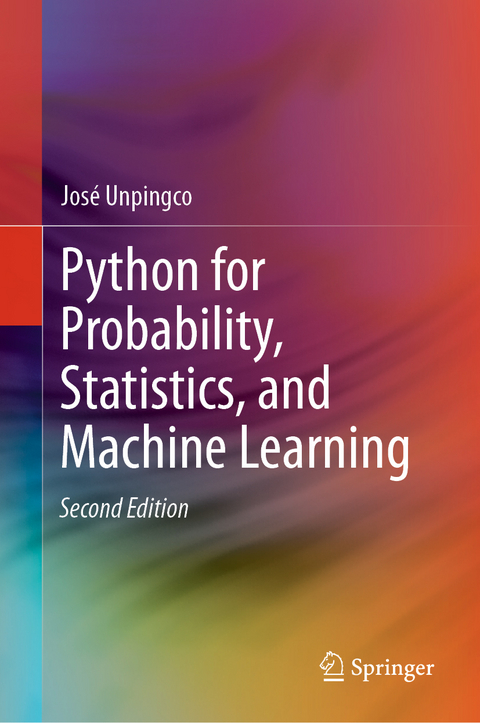
Python for Probability, Statistics, and Machine Learning
Springer International Publishing (Verlag)
978-3-030-18544-2 (ISBN)
This updated edition now includes the Fisher Exact Test and the Mann-Whitney-Wilcoxon Test. A new section on survival analysis has been included as well as substantial development of Generalized Linear Models. The new deep learning section for image processing includes an in-depth discussion of gradient descent methods that underpin all deep learning algorithms. As with the prior edition, there are new and updated *Programming Tips* that the illustrate effective Python modules and methods for scientific programming and machine learning. There are 445 run-able code blocks with corresponding outputs that have been tested for accuracy. Over 158 graphical visualizations (almost all generated using Python) illustrate the concepts that are developed both in code and in mathematics. We also discuss and use key Python modules such as Numpy, Scikit-learn, Sympy, Scipy, Lifelines, CvxPy, Theano, Matplotlib, Pandas, Tensorflow, Statsmodels, and Keras.
This book is suitable for anyone with an undergraduate-level exposure to probability, statistics, or machine learning and with rudimentary knowledge of Python programming.
Dr. José Unpingco completed his PhD at the University of California, San Diego in 1997 and has since worked in industry as an engineer, consultant, and instructor on a wide-variety of advanced data processing and analysis topics, with deep experience in machine learning and statistics. As the onsite technical director for large-scale Signal and Image Processing for the Department of Defense (DoD), he spearheaded the DoD-wide adoption of scientific Python. He also trained over 600 scientists and engineers to effectively utilize Python for a wide range of scientific topics -- from weather modeling to antenna analysis. Dr. Unpingco is the cofounder and Senior Director for Data Science at a non-profit Medical Research Organization in San Diego, California. He also teaches programming for data analysis at the University of California, San Diego for engineering undergraduate/graduate students. He is author of Python for Signal Processing (Springer 2014) and Python for Probability, Statistics, and Machine Learning (2016)
Introduction.- Part 1 Getting Started with Scientific Python.- Installation and Setup.- Numpy.- Matplotlib.- Ipython.- Jupyter Notebook.- Scipy.- Pandas.- Sympy.- Interfacing with Compiled Libraries.- Integrated Development Environments.- Quick Guide to Performance and Parallel Programming.- Other Resources.- Part 2 Probability.- Introduction.- Projection Methods.- Conditional Expectation as Projection.- Conditional Expectation and Mean Squared Error.- Worked Examples of Conditional Expectation and Mean Square Error Optimization.- Useful Distributions.- Information Entropy.- Moment Generating Functions.- Monte Carlo Sampling Methods.- Useful Inequalities.- Part 3 Statistics.- Python Modules for Statistics.- Types of Convergence.- Estimation Using Maximum Likelihood.- Hypothesis Testing and P-Values.- Confidence Intervals.- Linear Regression.- Maximum A-Posteriori.- Robust Statistics.- Bootstrapping.- Gauss Markov.- Nonparametric Methods.- Survival Analysis.- Part 4 Machine Learning.- Introduction.- Python Machine Learning Modules.- Theory of Learning.- Decision Trees.- Boosting Trees.- Logistic Regression.- Generalized Linear Models.- Regularization.- Support Vector Machines.- Dimensionality Reduction.- Clustering.- Ensemble Methods.- Deep Learning.- Notation.- References.- Index.
lt;p>"The book is aimed primarily at intermediate or advanced Python programmers ... . this work is a generally sound and comprehensive overview of the areas it covers. We recommend it to Python programmers interested in growing in these areas or experts in these areas interested in learning how to deal with them in Python." (Eugene Callahan and Yujia Zhang, Computing Reviews, October 15, 2020)
| Erscheinungsdatum | 14.07.2019 |
|---|---|
| Zusatzinfo | XIV, 384 p. 165 illus., 37 illus. in color. |
| Verlagsort | Cham |
| Sprache | englisch |
| Maße | 155 x 235 mm |
| Gewicht | 757 g |
| Themenwelt | Technik ► Elektrotechnik / Energietechnik |
| Technik ► Nachrichtentechnik | |
| Schlagworte | IPython Notebooks • machine learning • mathematical objects • Numerical Computation and Visualization • Open Source Python Toolchain • probability and statistics • Scientific Python • Sequentially Related Random Events • Statistical estimation |
| ISBN-10 | 3-030-18544-3 / 3030185443 |
| ISBN-13 | 978-3-030-18544-2 / 9783030185442 |
| Zustand | Neuware |
| Haben Sie eine Frage zum Produkt? |
aus dem Bereich



